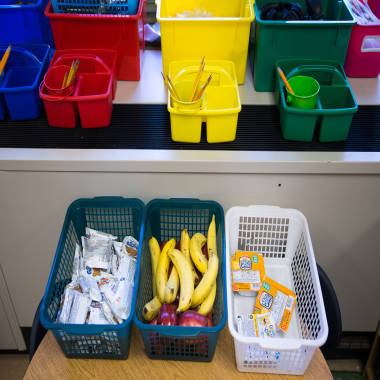NBC News – Before the day’s assignments begin, kindergarteners at Enrico Fermi School No. 17 in Rochester, N.Y., know there’s one ritual that always comes first: eating together.
Their teacher, Marie Rice, has already placed each child’s breakfast of apples, cereal, milk and cheese sticks on their desk. Before digging in, Ja’Cariya Clayton, 5, helps two less dexterous 4-year-old boys open their food packaging.
It’s the first year the preK-8 school has offered breakfast in the classroom, a program that’s no-cost to families and is curbing hunger and tardiness, school officials say. “Our kids are not used to getting a lot,” said David Brown, Food Service Director at Rochester City School District, where 90 percent of the kids are eligible for free or reduced meals and several kids are in and out of homeless shelters. “Anything we can do to ‘wow’ them is always appreciated.”
Similar class time meal programs have been adopted in several states including Arkansas, West Virginia, Vermont and Colorado, where ‘Breakfast After the Bell,’ requires hundreds of schools to make breakfast available in the classroom, after first period or as a grab-and-go cart.
Breakfast in the classroom starts the day in “a very calm and quiet manner,” Rice said of her 28 students. “They view themselves as more of a family because they are dining together.”
When asked how she feels after eating breakfast, Ja-Cariya thought for a moment before saying, “Happy.” Her favorite part: “Eating a meal with my friends.”
Zacari Spraggins, 5, like most of the kids in class, doesn’t eat breakfast at home. Eating at school, he said, “helps me keep awake.”
‘It tells children we care about them’
In the past, getting children to eat breakfast at school hasn’t been easy — even in districts where needy kids go hungry on a daily basis. Children who qualify for free meals often feel stigmatized when they’re the only ones in the food line who don’t pay, and arriving at school early to eat breakfast in the cafeteria isn’t always possible if parents are rushing to work, or if the school bus runs late.
“I have several kids who have two parents at home, both parents working, working minimum wage jobs,” said Rice. “It’s all mom and dad can do to actually afford housing, and cars that can get them to and from their jobs … so it’s relieved the burden off the parents who don’t have access to a lot of money.”
Soon, said Principal Ralph Spezio, School No. 17 will transition into serving hot breakfast, such as waffles, eggs and breakfast pizza.

For students who are still hungry throughout the day, extra food is stored in these bins at Enrico Fermi School No. 17. Between 750-1,000 students in the Rochester, N.Y., school district live in shelters.
“One thing that’s important, especially in high poverty neighborhood is … in order to learn, you have to feel cared for, you have to feel safe, you have to feel emotionally calm,” he said. “Everybody knows that having a good breakfast is the start of a good day for fueling the brain and learning. It also tells children that we care about them.”
Breakfast in the classroom is bound to become even more prevalent next year when a new government program goes nationwide.
The so-called Community Eligibility Option provides federal funding to school districts in poverty-stricken communities that give all students free breakfast and lunch, regardless of income level. With the new program, as long as 40 percent or more of students at a school receive food stamps, or other specific types of federal assistance, any child can receive two free meals a day without the need for applications or income-based tracking.
Ten states and the District of Columbia are currently participating, but every state will be eligible in the 2014-2015 school year.
In Michigan, where the program was phased in during the 2011-12 school year, educators are marveling at its impact.
Betti Wiggins, executive director of the Office of Food Services at Detroit Public Schools, said more low-income high school students are lining up in the cafeteria now that they’re no longer identified as free or reduced-cost meal recipients. “There’s no categorical counting of the meals,” she said. “We all just eat.”
Giving kids structure outside the home
Kindergarten teacher Janice Tillmon, who has taught at Detroit’s Brewer Elementary-Middle School for the past two years, said, “It benefits my kids in three ways: nutritionally, socially and emotionally.”
When school begins, two students are assigned to go to the cafeteria and bring breakfast back to the room. Two others pour milk, making sure everyone has just the right amount.
“It helps them feel like they have a sense of belonging,” Tillmon said.
One day, she said, a kindergartner known for her perfect attendance came in late, missed breakfast, and was acting up in class. Tillmon took the child aside to find out what was wrong, and the girl began to cry.
Finally she admitted she was hungry – because the last time she ate was at school, the day prior.
Click here to read more.
Editor’s note: This story is one in a series on education issues featured at the 2013 Education Nation summit in New York City on Oct. 6-8. To learn more, please visit EducationNation.com.

